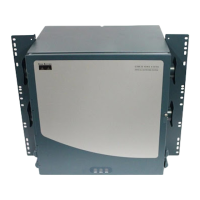20-86
Cisco ONS 15454 Procedure Guide, R5.0
March 2005
Chapter 20 DLPs A300 to A399
DLP-A390 View Alarms
Table 20-13 lists the color codes for alarm and condition severities.
Step 2 If alarms are present, refer to the Cisco ONS 15454 Troubleshooting Guide for information and
troubleshooting procedures.
Step 3 Return to your originating procedure (NTP).
Table 20-12 Alarm Column Descriptions
Column Information Recorded
Num Sequence number of the original alarm.
Ref Reference number of the original alarm.
New Indicates a new alarm; to change this status, click either the Synchronize button or
the Delete Cleared Alarms button.
Date Date and time of the alarm.
Object TL1 access identifier (AID) for the alarmed object; for an STSmon or VTmon, this is
the monitored STS or VT.
Eqpt Type If an alarm is raised on a card, the card type in this slot.
Slot If an alarm is raised on a card, the slot where the alarm occurred (appears only in
network and node view).
Port If an alarm is raised on a card, the port where the alarm is raised; for STSTerm and
VTTerm, the port refers to the upstream card it is partnered with.
Path Width Indicates how many STSs are contained in the alarmed path. This information
complements the alarm object notation, which is described in the Cisco ONS 15454
Troubleshooting Guide.
Sev Severity level: CR (Critical), MJ (Major), MN (Minor), NA (Not Alarmed), NR
(Not Reported).
ST Status: R (raised), C (clear).
SA When checked, indicates a service-affecting alarm.
Cond The error message/alarm name; these names are alphabetically defined in the
Cisco ONS 15454 Troubleshooting Guide.
Description Description of the alarm.
Table 20-13 Color Codes for Alarms and Condition Severities
Color Description
Red Raised Critical (CR) alarm
Orange Raised Major (MJ) alarm
Yellow Raised Minor (MN) alarm
Magenta (pink) Raised Not Alarmed (NA) condition
Blue Raised Not Reported (NR) condition
White Cleared (C) alarm or condition

